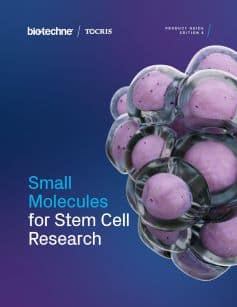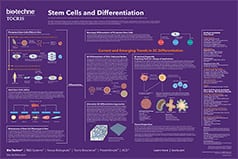Stem Cell Reprogramming
Stem Cell Reprogramming typically refers to the regression of a specialized cell to a simpler state, resulting in cells with stem-like properties. This process occurs naturally, mostly for repair and regeneration in aged or damaged tissues, but can also be artificially induced using transcription factors and/or chemical reagents. Specialized cells may also be reprogrammed directly into another cell type, a process termed transdifferentiation.
View all pluripotent stem cell resources available from Bio-Techne.
Kits |
|
|---|---|
| Cat. No. | Product Name / Activity |
| 7991 | CEPT Cocktail Kit |
| Cell culture supplement for improving stem cell survival | |
Other |
|
| Cat. No. | Product Name / Activity |
| 4055 | L-Ascorbic acid |
| Enhances the generation of iPSCs; increases reprogramming efficiency | |
| 3842 | 5-Azacytidine |
| DNA methyltransferase inhibitor; improves reprogramming efficiency | |
| 1544 | (±)-Bay K 8644 |
| Ca2+ channel activator (L-type); aids generation of iPSCs from MEFs | |
| 5819 | Bexarotene |
| Potent and selective RXR agonist; induces brown adipogenic reprogramming from myoblasts | |
| 5989 | BIRB 796 |
| Used in the reprogramming of somatic cells to ciPSCs; high affinity and selective p38 kinase inhibitor | |
| 3364 | BIX 01294 |
| GLP and G9a inhibitor; potentiates induction of iPSCs | |
| 5015 | 5-BrdU |
| Enhances Yamanaka factor reprogramming and replaces Oct-4 in transcription factor-mediated reprogramming; synthetic thymidine analog | |
| 3302 | CD 3254 |
| Promotes mouse fibroblasts chemical reprogramming; Potent and selective RXRa agonist | |
| 6695 | CHIR 98014 |
| Highly potent and selective GSK-3 inhibitor; can be used in differentiation and reprogramming of stem cells | |
| 4423 | CHIR 99021 |
| Highly selective GSK-3 inhibitor; enables reprogramming of mouse embryonic fibroblasts into iPS cells | |
| 7163 | Chroman 1 |
| Highly potent and selective ROCK 2 inhibitor; improves cell survival after cryogenesis | |
| 5331 | CPI 203 |
| Enhances reprogramming at low concentration; BET bromodomain inhibitor | |
| 4489 | DBZ |
| Notch signaling pathway inhibitor; stimulates formation of iPSCs | |
| 4703 | 3-Deazaneplanocin A hydrochloride |
| Histone methyltransferase inhibitor; enhances Oct4 expression in chemically-induced pluripotent stem cells | |
| 1425 | (S)-(+)-Dimethindene maleate |
| Allows formation of extended pluripotent stem (EPS) cells; also M2-selective antagonist | |
| 4126 | DMH-1 |
| Used in the reprogramming of somatic cells to ciPSCs; selective ALK2 inhibitor | |
| 3093 | Dorsomorphin dihydrochloride |
| Used in the reprogramming of somatic cells to ciPSCs; BMP type I receptor inhibitor | |
| 6340 | Epiblastin A |
| Converts epiblast stem cells to ESCs and promotes ESC self-renewal; CK1 inhibitor | |
| 5567 | EPZ 004777 |
| Improves reprogramming efficiency; highly potent DOT1L inhibitor | |
| 7807 | Hh-Ag1.5 |
| Promotes mouse embryonic fibroblasts reprogramming into neural stem cells; potent and high affinity Smo receptor agonist | |
| 3533 | IWP 2 |
| Used in the reprogramming of somatic cells to ciPSCs; PORCN inhibitor | |
| 6976 | JNJ 10198409 |
| Induces reprogramming of fibroblasts into functional cardiomyocytes (9C cocktail); potent PDGFRα and PDGFRβ inhbitor | |
| 1398 | Kenpaullone |
| Promotes generation of iPSCs from somatic cells; inhibits GSK-3β and cdks | |
| 7743 | Linifanib |
| Promotes generation and reprogramming of iPSCs; also potent inhibitor of PDGFRβ, KDR, FLT3 and CSF-1R | |
| 3268 | Minocycline hydrochloride |
| Allows formation of extended pluripotent stem (EPS) cells; also antibiotic | |
| 3656 | Neurodazine |
| Induces neurogenesis in mature skeletal muscle cells | |
| 5664 | O4I2 |
| Oct3/4 inducer; induces expression of pluripotent-associated genes | |
| 4192 | PD 0325901 |
| Selective inhibitor of MEK1/2; enhances generation of iPSCs | |
| 2653 | Pifithrin-μ |
| Inhibitor of p53-mitochondrial binding | |
| 6070 | Pladienolide B |
| Reprogram pluripotent hESCs into zigotic genome activation (ZGA)-like cells (ZLCs) | |
| 7739 | Polyamine Supplement x1000 (lyophilized) |
| Media supplement to boost cell growth; used as component of CEPT cocktail to enhance stem cell viability | |
| 3742 | RepSox |
| Selective TGF-βRI inhibitor; enhances reprogramming efficiency | |
| 3295 | RG 108 |
| Non-nucleoside DNA methyltransferase inhibitor; enhances efficiency of iPSC generation | |
| 7064 | Ruxolitinib |
| Used in the reprogramming of somatic cells to ciPSCs; JAK 1/2 inhibitor | |
| 6390 | SAG dihydrochloride |
| Used in the reprogramming of somatic cells to ciPSCs; Smo receptor agonist | |
| 4652 | SAHA |
| Increases efficiency of OSKM-induced reprogramming of MEFs to iPSCs; class I and II HDAC inhibitor | |
| 1614 | SB 431542 |
| Replaces SOX2 in reprogramming protocols; potent and selective inhibitor of TGF-βRI, ALK4 and ALK7 | |
| 2650 | SB 590885 |
| Used in the reprogramming of somatic cells to ciPSCs; B-Raf inhibitor inhibitor | |
| 4889 | SGC-CBP30 |
| Used in the reprogramming of somatic cells to ciPSCs; potent CBP/p300 BRD inhibitor | |
| 4297 | SMER 28 |
| Promotes reprogramming of fibroblasts to neural stem-like cells | |
| 3845 | Thiazovivin |
| Improves the efficiency of fibroblast reprogramming and induction of iPSCs; ROCK inhibitor | |
| 7340 | Tocriscreen Stem Cell Library |
| A library of 120 stem cell compounds (100 μL 10 mM DMSO solutions) to explore stem cell reprogramming, differentiation, proliferation and signaling | |
| 3852 | Tranylcypromine hydrochloride |
| Irreversible inhibitor of LSD1; enables reprogramming of mouse embryonic fibroblasts into iPS cells | |
| 1406 | Trichostatin A |
| Potent histone deacetylase inhibitor; induces accelerated dedifferentiation of primordial germ cells | |
| 0761 | TTNPB |
| Retinoic acid analog; enhances efficiency of reprogramming in CiPSCs | |
| 3861 | UNC 0224 |
| Used in the reprogramming of somatic cells to ciPSCs; G9a and GLP inhibitor | |
| 2815 | Valproic acid, sodium salt |
| Histone deacetylase inhibitor; enables induction of pluripotent stem cells from somatic cells | |
| 1254 | Y-27632 dihydrochloride |
| Selective ROCK inhibitor; part of cocktail used to induce neurons from fibroblasts | |
| 7000 | Y-27632 in solution New |
| Sterile-filtered 10 mM solution of Y-27632 pre-dissolved in water | |
Reprogramming of cells refers to the regression of a specialized cell to a simpler state, resulting in cells with stem-like properties, or the direct transformation of one specialized cell type into another, which is also known as transdifferentiation. The process of cells regressing to a stem cell-like state occurs naturally, mostly for repair and regeneration in aged or damaged tissues, being also known as dedifferentiation. Reprogramming can be artificially induced using a combination of transcription factors and/or chemical reagents. This was first demonstrated by Takahashi and Yamanaka in 2006. They reprogrammed mouse fibroblasts into cells having embryonic stem cell-like properties by the introduction of the transcription factors Oct-4, Sox2, c-Myc and KIf4, using viral vectors; the resulting cells were designated induced pluripotent stem cells, or iPSCs.
The use of transcription factors in the reprogramming of cells, however, is not only inefficient but is also associated with a risk of introducing genetic mutations when inserting a transgene into the target cell's genome. Subsequent research has shown that transcription factors can be replaced with various small molecules in the generation of induced pluripotent stem cells. The use of chemicals to reprogram cells reduces the potential for introducing genetic mutations into the cells, as well as lowering the risk of tumor formation. It can also improve the efficiency of reprogramming. Cells reprogrammed using small molecules are termed chemically induced pluripotent stem cells or ciPSCs (see Stem Cell Protocols for more information).
Chemical Reprogramming of Stem Cells

Figure 1: Schematic outlining a protocol for the chemical reprogramming of mouse embryonic fibroblasts into induced pluripotent stem cells (iPSCs). V, Valproic acid; C, CHIR 99021; 6, Repsox; T, Tranylcypromine; F, Forskolin.
From Hou et al. (2013) Pluripotent stem cells induced from mouse somatic cells by small-molecule compounds. Science 341, 651. PMID: 23868920
iPSCs are valuable in biomedical research as they are pluripotent and can therefore theoretically be differentiated into any cell type. As such they have potential in drug screening and toxicity testing. They are also likely to be of use in regenerative medicine, to repair damaged tissue for example following trauma or in Parkinson's disease, or to generate human organ tissues for organ transplantation. The use of iPSCs in medicine has the advantage that the cells are autologous (self), limiting the risk of immune rejection and eliminating the need for using embryonic stem cells.
Transdifferentiation is the process by which functionally mature cells are reprogrammed directly into a different specialized cell type without passing through the iPSC state; this is also known as direct lineage reprogramming. Small molecules can also be used to transdifferentiate cells from one cell type to another. This process also occurs naturally.
Reference:
Takahashi and Yamanaka (2006) Induction of pluripotent stem cells from mouse embryonic and adult fibroblast cultures by defined factors. Cell 125, 663. PMID: 16904174
Related Product From Bio-Techne
Literature for Stem Cell Reprogramming
Tocris offers the following scientific literature for Stem Cell Reprogramming to showcase our products. We invite you to request* your copy today!
*Please note that Tocris will only send literature to established scientific business / institute addresses.
Stem Cells Scientific Review
Written by Kirsty E. Clarke, Victoria B. Christie, Andy Whiting and Stefan A. Przyborski, this review provides an overview of the use of small molecules in the control of stem cell growth and differentiation. Key signaling pathways are highlighted, and the regulation of ES cell self-renewal and somatic cell reprogramming is discussed. Compounds available from Tocris are listed.
Stem Cell Workflow Poster
Stem cells have potential as a source of cells and tissues for research and treatment of disease. This poster summarizes some key protocols demonstrating the use of small molecules across the stem cell workflow, from reprogramming, through self-renewal, storage and differentiation to verification. Advantages of using small molecules are also highlighted.



